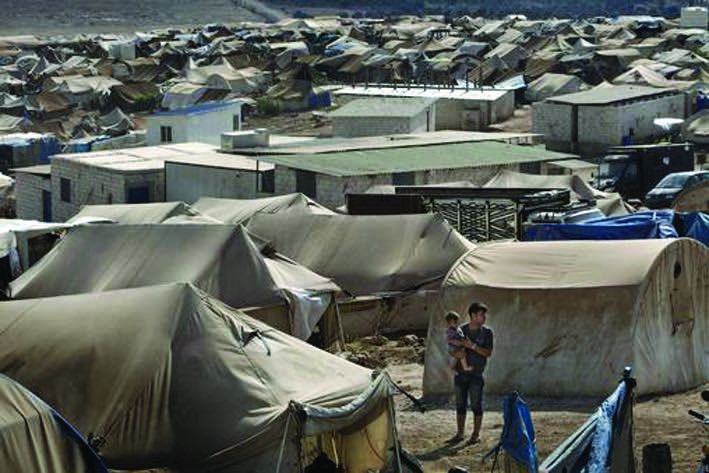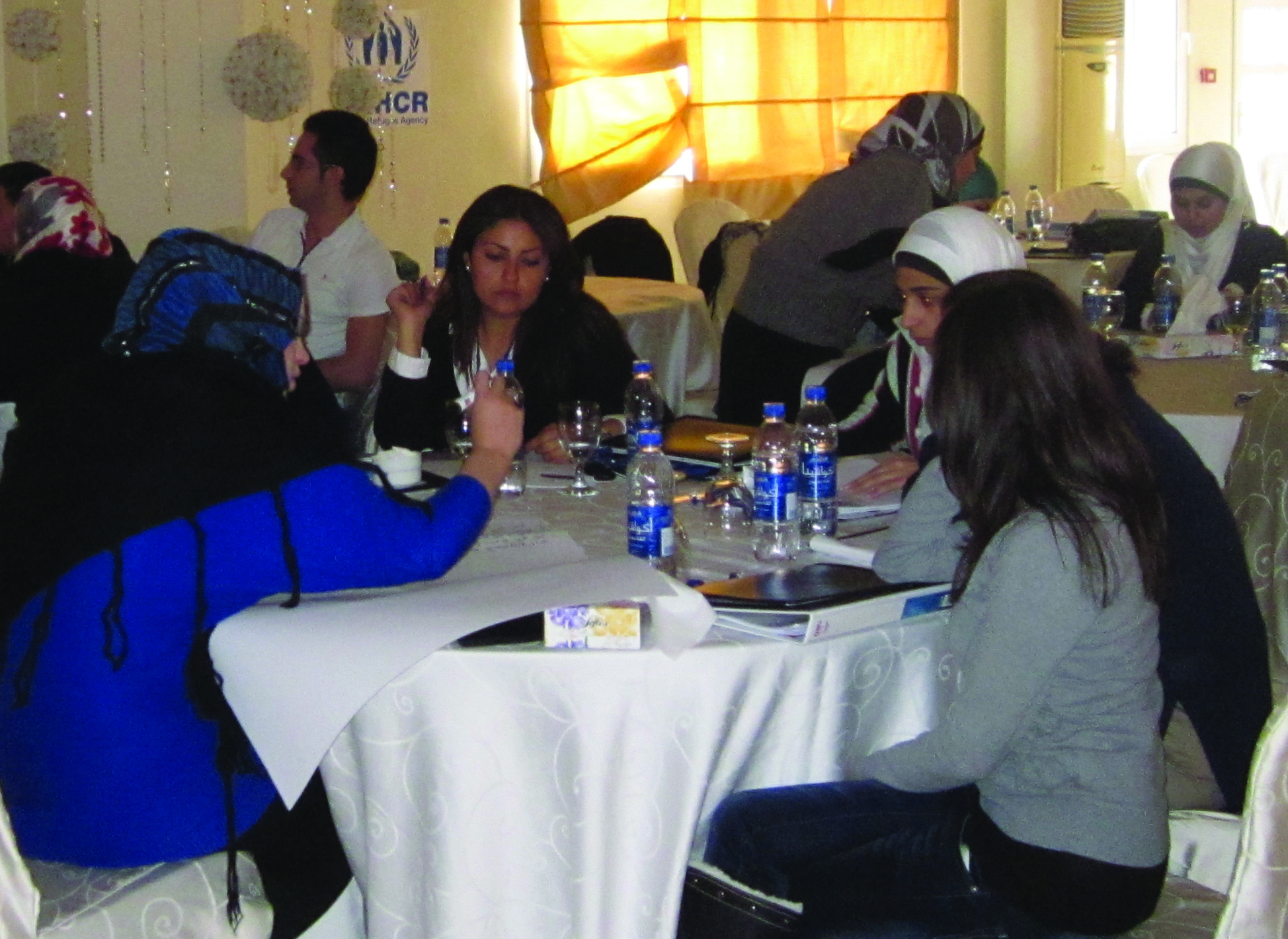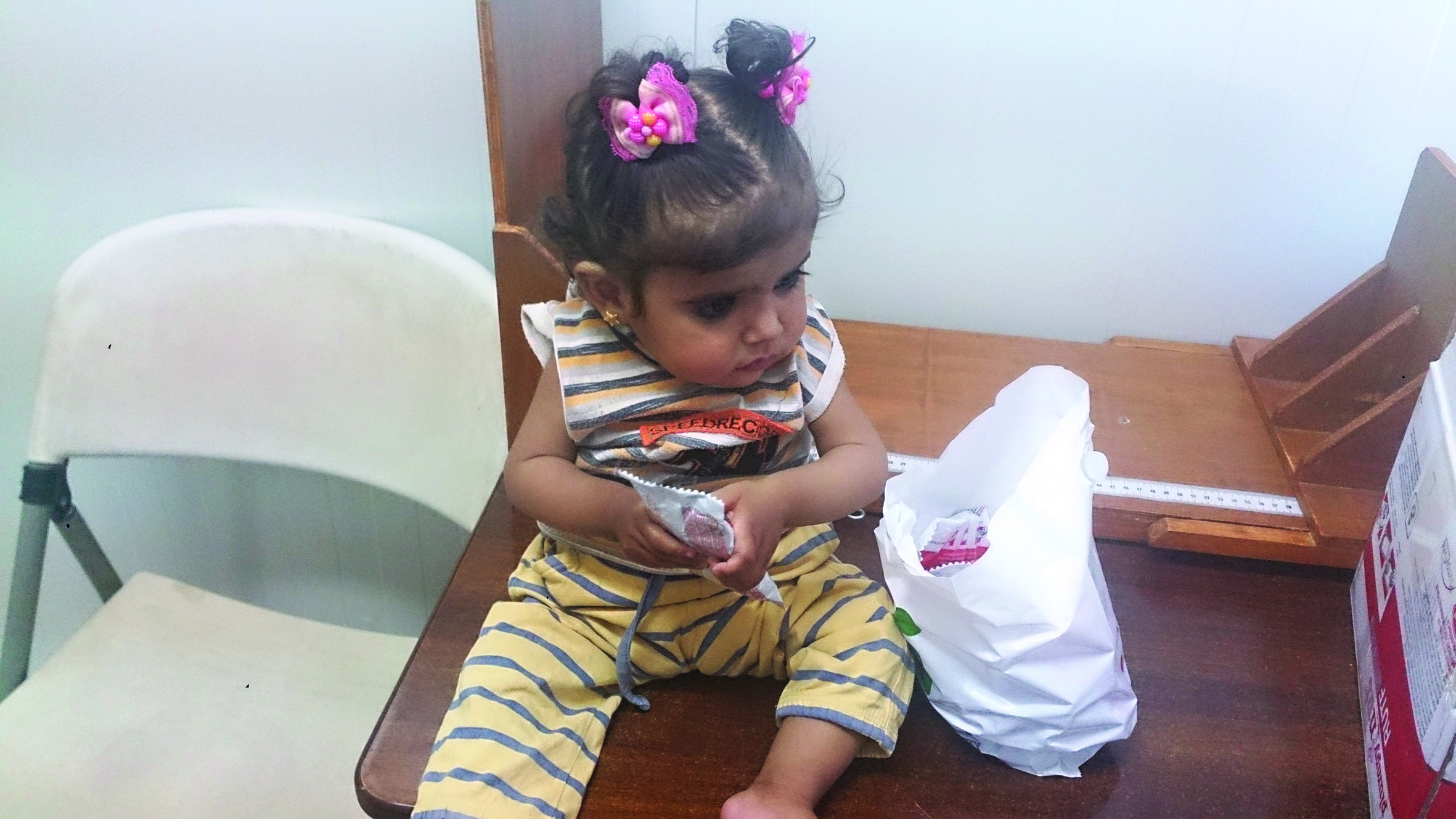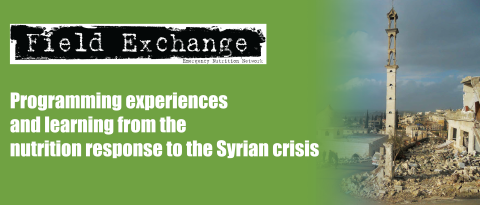Nutrition response in Syria: UNICEF’s perspective
 By James Kingori, Dr Hayder Nasser, Muhiadin Abdullahi and Dr Khaldoun Al-Asaad
By James Kingori, Dr Hayder Nasser, Muhiadin Abdullahi and Dr Khaldoun Al-Asaad
James Kingori is the UNICEF Regional Nutrition Specialist for UNICEF’s Middle East and Northern Africa (MENA) Regional Office since April 2011, based in Jordan.
Dr. Haydar Nasser is the Chief of Health and Nutrition at UNICEF Syria.
Muhiadin Abdullahi is Nutrition Specialist with UNICEF Syria.
Dr Khaldoun Al-Asaad is Nutrition Officer with UNICEF Syria.
Background
Syria is in the fourth year of escalating crisis1 and the impact on the population cannot be overestimated. The humanitarian situation in Syria has deteriorated significantly since late 2012/early 2013 with an estimated 6.5 million people displaced as of October 2013 (2014 Syria Humanitarian Assistance Response Plan – SHARP, Dec 2013) and 2.3 million refugees by the end of 2013 (Regional Response Plan for Syrian Refugees, Dec 2013). On-going conflict, population displacement, breakdown in social and public services, intermittent reports of droughts since 2011 and disruption of peoples’ livelihoods, have the potential to have an effect on the health, food security and eventually on nutritional status of the affected population. The refugees are hosted in Lebanon, Jordan, Iraq, Turkey and Egypt.
The overall nutrition situation before the crisis was poor with an estimated 23% stunting prevalence, 9.3% wasting and 10.3% underweight2. Exclusive breastfeeding rates stood at 42.6% while the proportion of newborns introduced to breastfeeding within the first hour of birth was 42.2% (SFHS, 2009). Micronutrient deficiencies have also been recorded in Syria in the past, presenting risk for sub-optimal growth among children, e.g. pre-crisis anaemia prevalence among 0-59 month old children was 29.2% (MOH, nutrition surveillance system report 2011), 8.7% Vitamin A deficiency rate (MOH, 1998) and 12.9% iodine deficiency prevalence (MOH, 2006).
The ongoing crisis in Syria has disrupted peoples’ daily life, affected their livelihoods, caused displacement and threatened people’s wellbeing. As this crisis persists, a considerable proportion of the population continues to depend on food aid (channelled through direct distribution or via cash and voucher systems) for survival. Compromises that would have impact on nutrition are, however, likely in terms of dietary diversity and frequency, separation of children from caretakers thus affecting infant and young child feeding (IYCF) practices, poor water sanitation and hygiene WASH) conditions predisposing to diseases, destruction of health facilities and loss of health professional leading to insufficient health care, among others. These prevailing factors necessitate increased attention to nutrition, to prevent any deterioration and nutrition-related deaths.
There has been no documented nutrition crisis to date in Syria and the neighbouring countries of Turkey, Iraq, Jordan and Lebanon that are receiving Syrian refugees. However, the ongoing conflict in Syria and the resultant population displacement necessitates response to address prevailing sub-optimal nutrition issues while developing preparedness plans to be able to deliver any critical nutrition responses that may be needed in the future. This involves enhancing capacity for close monitoring of the nutrition situation for women and children, identifying and treating cases of acute malnutrition that arise and strengthening preventive interventions like infant and young child feeding (IYCF) support and micronutrient supplementation. It is important to note that all these countries are categorised as middle income countries (World Bank, 20133). Generally speaking, nutrition is often not a priority sector in some middle income countries and they happen to have limited emergency nutrition preparedness and response capacity; e.g. no government endorsed national nutrition guidelines/ protocols for both prevention and treatment for malnutrition or fully fledged nutrition department with trained nutrition technical staffs; few, if any, technical nutrition non-governmental organisations (NGOs); limited government budget for nutrition, etc .
This article describes the evolution and status of the Syria crisis nutrition response and nutrition response advocacy effort from UNICEF’s perspective and provides an overview of UNICEF supported regional and national capacity strengthening initiatives around nutrition in emergencies.
Evolution of the Syria crisis nutrition response
Positioning of nutrition in the humanitarian response
The need to establish the nutrition situation of the affected Syrian population was identified back in late 2011 following reports of below normal rains in the northern governorate of Syria. However, with the escalation of the conflict and subsequent limited access, this initiative could not proceed and was superseded by other humanitarian priorities, such as tracking population movement and facilitating population safety, ensuring adequate daily food and water, etc. With the intensification of the crisis in Syria and the neighbouring countries receiving refugees, sectors like water, sanitation and hygiene (WASH), health, protection, education and food security were identified as priorities back in 2012, with nutrition not featuring prominently.
Advocacy for nutrition as a first line of intervention and raising its profile nationally was nevertheless pursued by UNICEF and other stakeholders. However, ‘selling’ nutrition to the wider humanitarian community was challenging as there was no glaring ‘nutrition crisis’ (i.e. no severely emaciated children reported) like in most global emergencies. The only official government report on nutrition within Syria4 reported a ‘poor’ situation, according to WHO nutrition situation classification criteria. The 2009 SFHS was viewed by most stakeholders as old data to depict the current situation and therefore not adequate for response planning. Furthermore, the absence of any significant caseload of acutely malnourished children reported during the routine screening in health facilities and the delay in implementing the proposed nutrition survey in Syria (a nutrition assessment was eventually started in March 2014) meant that it was difficult to convince many in the humanitarian community, including some donors, of the need to prioritise a nutrition response within Syria. The identified need for preventative nutrition interventions (support to IYCF and micronutrient interventions, basic capacity strengthening and associated coordination), in spite of their relevance, didn’t trigger much interest at the early stages of nutrition response.
Despite these challenges, nutrition advocacy has continued unabated through building evidence, making presentations in various fora, and bilateral discussions and sensitisation of strategic partners since late 2012. The basic messages communicated through this active nutrition advocacy has been that though there is no documented evidence of a nutrition crisis as yet, malnutrition and related preventable death can occur should there be a lapse in other basic services of water sanitation and hygiene,, health, food security and other relevant interventions. Hence preventive nutrition activities and capacity strengthening are regarded as paramount to avert nutritional deterioration. The need to know what infants and young children are eating and the importance of preventing acute malnutrition and stunting through an integrated response were some of the strategic messages used in advocating for more resources to be directed towards nutrition in the current emergency.
In the pre-crisis period in Syria, some aspects of IYCF and micronutrient issues (iron deficiency, in particular) were given some attention through the advocacy for food fortification and iron supplements delivered to mothers through antenatal care services. Advocacy for dietary diversity has been maintained during the emergency response, with deliberate targeting of children and mothers. Lipid-based Nutrient Supplements (LNS) (Plumpy’doz) and micronutrient powders (MNP) have been distributed in Syria and Lebanon while Super Cereal Plus targeting children aged 6-23 months and beyond has also been distributed in Syria and Jordan. UNICEF has been procuring some of these products in coordination with WFP. Much of the response, coordination and strategic discussion are held under the auspices of UNICEF.
Further, due to the recognised need for improved IYCF related programming in the emergency context, the Global Nutrition Cluster (GNC) in collaboration with nutrition stakeholders in the Syria, Lebanon, Iraq and Jordan compiled a comprehensive presentation on promotion and protection of appropriate IYCF practices in emergencies. This was used for some of the specific targeted advocacy within the region by some GNC members led by UNICEF, through presentations in meetings, wide sharing of the comprehensive presentation, and maintaining regular contacts. IYCF support and close monitoring of the nutrition situation through facility based screening and rapid assessment became the primary nutrition response across the five countries significantly affected by the Syria crisis.
Overall, these various advocacy efforts have led to some successes in positioning nutrition as one of the sectors to be prioritised in the ongoing humanitarian response.
 Successes from the nutrition advocacy effort
Successes from the nutrition advocacy effort
Nutrition reflected in the Syria Arab Republic’s Humanitarian Assistance Response Plan (SHARP): For the first time, an independent sector response plan for nutrition was introduced in the SHARP (version 5) document developed in April 2013. This sectoral plan articulates the priority for nutrition sector and associated funding needs to allow delivery of a response in the challenging operating environment within Syria and in the countries hosting the refugees. The (Syria) Regional Response Plans (RRP) drafted by the countries hosting Syrian refugees (Iraq, Jordan, Lebanon, Egypt and Turkey) do not have an independent nutrition response plan; instead nutrition is integrated in the health and food security response plans.
Nutrition sector established in Syria with Ministry of Health (MOH) and UNICEF co-leadership since April 2013: The advocacy for nutrition led to its recognition as a critical life-saving sector, in order to facilitate close monitoring of nutrition situation and evidence building, sector priority setting and sector specific strategy development, capacity strengthening, partnership fostering, nutrition response coverage and gaps analysis, etc. Nutrition response coordination is currently ongoing and opportunities for integration with other sectors is being explored and exploited in an effort to protect and promote better nutrition. A number of capacity building initiatives (training sessions, sharing of guidelines and technical discussions) have been organised; a nutrition assessment has been planned (see below); partnerships have been fostered (e.g. UNICEF, WHO and WFP with and the Syrian Arab Red Crescent (SARC) and other national NGOs; and a response matrix (4W) has been drafted to enhance coverage and gaps analysis.
Syria nutrition sector strategy drafted and approved by the Ministry of Health (MOH) Syria in October 2013: This articulates broad priority response strategies for consideration by the various nutrition stakeholders. These include:
(a) Prevention of undernutrition through accelerated promotion of appropriate IYCF, ensuring improved coverage of appropriate micronutrient intervention and promotion of nutrition sensitive responses alongside positive behaviour change activities
(b) Supporting the identification and treatment of acutely malnourished cases using internationally approved guidelines and treatment products
(c) Strengthening the nutrition surveillance system through supporting facility based and community based screening for malnutrition, as well as conducting comprehensive nutrition assessments
(d) Strengthened coordination of the nutrition response through promotion of the nutrition sector priority responses (surveillance, IYCF, micronutrient supplementation and treatment of identified malnourished child), and
e) Supporting integration of nutrition with other sectoral responses.
 Nutrition assessment to update nutrition situation. Two rounds of nutrition assessments for the refugees in Jordan and Lebanon have been accomplished, i.e. Lebanon Sept 2012 and Nov/Dec 2013 and Jordan Oct/Nov 2012 and April 2014 while a series of governorate level assessments among IDP children in collective shelters are in their final stages in Syria (April – Aug 2014). These new data will complement the facility based screening data on weight and height for children, programme reports and other qualitative information in the consolidation of the evidence on the nutrition situation for the Syrians within and outside Syria.
Nutrition assessment to update nutrition situation. Two rounds of nutrition assessments for the refugees in Jordan and Lebanon have been accomplished, i.e. Lebanon Sept 2012 and Nov/Dec 2013 and Jordan Oct/Nov 2012 and April 2014 while a series of governorate level assessments among IDP children in collective shelters are in their final stages in Syria (April – Aug 2014). These new data will complement the facility based screening data on weight and height for children, programme reports and other qualitative information in the consolidation of the evidence on the nutrition situation for the Syrians within and outside Syria.
Capacity strengthening initiatives. A series of trainings have been conducted targeting technical public health specialists from Syria, Lebanon, Jordan, Iraq, Turkey and Egypt. These include a number of Nutrition in Emergencies trainings with emphasis on IYCF in emergencies, specific IYCF training and briefing sessions during coordination, rapid assessment and community and facility based screening, and full five day sector/cluster coordination training (see details below). Various United Nations (UN) agencies and NGOs have also deployed technical nutrition staff in the past year to facilitate implementation of various nutrition related programmes. An IYCF in emergencies specialist was deployed by UNICEF (in collaboration with Save the Children Jordan) for six months (mid Feb – mid Aug 2014) to support the consolidation of information and bridging of technical gaps particularly with respect to IYCF (again, see details below).
Conclusions
In conclusion, although advocacy for nutrition has led to a stronger positioning of nutrition within the overall regional response, much is yet to be accomplished. The established humanitarian coordination structure with nutrition being one of the prioritised sectors in Syria, building of an evidence base to inform the response, monitoring, as well as response capacity, will need continued investment and support to ensure adequate provision for the treatment of identified malnourished children and to prevent deterioration of the situation.
Regional and country capacity strengthening development on nutrition
Nutrition related capacity strengthening efforts undertaken by the UNICEF Middle East and Northern Africa Regional Office (MENARO), as well as country offices and other nutrition stakeholders, are described below. This capacity strengthening effort has been necessitated by the technical gap existing on nutrition in emergencies in the Syria crisis affected countries, the need to adequately prepare for any possibility for nutrition situation deterioration and the need to enhance the quality of the ongoing nutrition response.
Nutrition in Emergencies (NIE) training (2012 and 2014)
To address the existing capacity gap for identifying and treating acutely malnourished children, two regional/multi-country training were organised by UNICEF in Jordan (June 2013) and Lebanon (June 2014), followed by additional cascaded training at country level. These NIE trainings were based on the Global Nutrition Cluster (GNC) endorsed Harmonised Training Package (HTP)5 with an emphasis on IYCF in emergencies (IYCF-E) and screening for acute malnutrition at the community level. UNICEF MENARO organised the training in June 2013 in Jordan reaching 41 MOH, UN and NGO public health professionals from Syria, Turkey, Lebanon, Jordan, Iraq and Egypt (See Table 1).
UNHCR conducted NIE training using the same package in December 2012 for their staff and partners in Jordan. In May 2014, UNICEF Turkey conducted NIE training for NGOs, UN agencies and the Turkish Red Crescent, benefiting 25 participants. In June 2014, UNICEF Lebanon in partnership with the American University of Beirut (AUB) in collaboration with the Institute of Child Health of the University College of London (UCL) organised a similar NIE training, largely targeting nutrition stakeholders from Lebanon and Syria, benefiting 35 participants from UN agencies, NGOs and MOH.
UNICEF, in collaboration with MOH Syria, has facilitated a series of Community based Management of Acute Malnutrition (CMAM) training activities for MOH and NGO staff6 from various governorates largely focusing on the identification of acutely malnourished children, their referral and treatment, as well as the integration of IYCF-E services into CMAM. This effort aims to ensure reasonable capacity exists to trigger an emergency nutrition response in every governorate, if the need arises or as access improves. The NIE training materials used in the June 2013 Jordan training have been translated into Arabic for use at national and sub-national levels.
Table 1: MENA RO/NIE training participants, June 2013 |
||||
Country |
UN |
NGO |
MOH/Government |
Total |
|
Jordan |
4 | 6 | 0 | 10 |
|
Iraq |
2 | 0 | 2 | 4 |
|
Syria |
5 | 3 | 3 | 11 |
|
Lebanon |
3 | 5 | 2 | 10 |
|
Egypt |
1 | 1 | 0 | 2 |
|
Turkey |
2 | 0 | 2 | 4 |
|
Total participants |
17 | 15 | 9 | 41 |
Infant and Young Child Feeding in emergencies (IYCF-E)
As described above, IYCF-E has been integrated into the NIE training7. In addition, UNICEF, in partnership with Save the Children Jordan (SCJ), has engaged the services of an IYCF-E specialist to conduct a situation analysis of the IYCF-E implementation activities, identify IYCF capacity gaps and provide guidance on IYCF programme implementation and progress monitoring. Implementing partners in Lebanon, Jordan, Iraq, Turkey and Syria have been supported by the IYCF-E specialist in accessing the appropriate IYCF-E training materials, translation of IYCF-E operational guidance for programmes and in the IYCF-E response monitoring. Lebanon IYCF programmes are also benefiting from the technical leadership of the National Breastfeeding Committee and the technical expertise of the International Orthodox Christian Charities (IOCC), facilitated through the IOCC partnership with UNICEF and in close collaboration with the Ministry of Public Health, Lebanon. In Turkey, special IYCF sessions were conducted in the Syrian refugee camps targeting women’s groups. These sessions were conducted in collaboration with the women’s committees that were organised by UNHCR. The sessions were conducted in an open forum where women could learn about the importance of exclusive breastfeeding, timely and adequate complementary feeding and feeding of non-breastfed infants. In Syria, IYCF-E has been integrated into the CMAM programmes established in various governorates while independent IYCF interventions are under development in partnership with national partners that are undertaking health promotion activities in the county.
Assessment and screening
Aspects of basic nutrition screening have been covered in the NIE training but additional training on rapid screening using Middle Upper Arm Circumference (MUAC) and height and weight measurements, as well as data interpretation, has been conducted in Jordan, Iraq, Lebanon and Syria. Assessment teams involved in the recent nutrition assessment in Syria have been exposed to the SMART methodology and the associated task of taking accurate anthropometric measurements. A SMART Survey Manager training for the MENA region was successfully conducted between 23rd and 29th August 2014, benefiting 26 public health professionals from emergency prone countries in MENA, particularly Syria and neighbouring countries.
Table 2: Cluster Training Participants |
||
Countries |
WASH |
Nutrition |
|
Yemen |
4 | 4 |
|
Sudan |
2 | 2 |
|
Jordan |
3 | 1 |
|
Syria |
8 | 4 |
|
Lebanon |
2 | 1 |
|
Palestine |
1 | 0 |
|
Total |
20 | 12 |
Cluster/sector coordination
The MENA regional cluster/sector coordination training was conducted between 6th – 10th October 2013 targeting the emergency prone countries in the MENA countries, benefiting 12 nutrition/public health professionals and 20 water and sanitation technical staff. A deliberate effort was made to conduct this joint nutrition/WASH training to foster inter-sectoral coordination, which is necessary in the prevention of malnutrition. All those trained can be deployed in any of the countries within the region on short notice to support response coordination. The training covered such topics as humanitarian reform, division of roles and responsibility among different stakeholders in an emergency context, humanitarian programme cycle, collaborative leadership, information management, resource mobilisation, inter-cluster coordination, systems and processes necessary for stronger coordination, transformative agenda, and technical standards/ references in emergency response and partnership. Additional sector-specific topics were also covered when the two groups (WASH vs Nutrition) were separated to focus on updating the participants’ technical knowledge on nutrition and WASH issues.
General support and supplies
Relevant guidelines have been provided to various stakeholders for reference. In addition, distant and on-site support has been provided through field visits and surge support by persons with specific technical expertise and experience. There has been ongoing communication with technical staff involved in programme implementation (through phone, webinars, skype calls) and technical discussion during the coordination meetings. The outlined capacity strengthening effort has been complemented by strategic pre-positioning of essential supplies such as micronutrients, therapeutic and supplementary food supplies, anthropometric equipment and development of information education and communication (IEC) materials necessary for the community level training and awareness raising/ social mobilisation.
 Conclusions
Conclusions
Additional capacity strengthening effort is needed through on the job training and regular guidance and supportive supervision for improved quality of intervention. This is an ongoing process that continues to be underscored in the various coordination forums in an effort to enhance nutrition programme quality and quality.
Final reflections by UNICEF
There is often an assumed association between a humanitarian crisis and a high global acute malnutrition rates with a resultant ‘automatic’ dispatch of Ready to Use Therapeutic Food (RUTF) and Ready to Use Supplementary Food (RUSF) thus translating into a misinformed response. There may also be an assumption that a nutrition crisis in a middle income country can be responded to by medical staff within the existing health care services, who could at times be without adequate exposure to emergency nutrition response. This necessitates consideration of the nutrition response capacity and the health system that existed before the crisis in the overall response planning and actual implementation. On IYCF, the need to monitor and prevent distribution of feeding bottles, facilitation of bottle substitution with cups and delivery of related education, may need to be better captured in the existing guidelines. Integration of IYCF-E and CMAM is often viewed as a new approach that requires a whole set of refresher training – yet it should be viewed as a best practice of dealing with situation that need both programme elements. Countries such as those in the Syria sub-region, need to be encouraged to have some contingency measures, such as capacity, essential nutrition supply in the pipeline, or at least knowledge of the channels through which to obtain these resources and support.
The Syria crisis experience has demonstrated that an occurrence of a humanitarian event does not always translate into an immediate nutrition crisis but this should not mean that nutrition is automatically relegated to a non-priority sector in the response planning by agencies and donors. Capacity strengthening and support to preventive services are critical. Efforts on regular generation of data, even in normal times, are essential to inform appropriate response while existing global guidelines play an important role in providing guidance to inform the response. Ingenuity will be required to ensure that global guidelines are adapted to the needs of contexts such as those in the MENA region.
For more information, contact: James Kingori: jkingori@unicef.org
1 The crisis is associated with violence, attacks on social and economic infrastructure and disruption of services. The unilateral economic and financial sanctions have further exacerbated the humanitarian situation (SHARP, Dec 2013, page 14)
2 Syrian Family Health Survey (SFHS), 2009.
3 http://data.worldbank.org/news/new-country-classifications: Syria and Egypt are lower Middle Income Countries while Jordan, Iraq and Lebanon are upper Middle Income Countries
4 Syria Family Health Survey, 2009
5 Available at: http://www.ennonline.net/resources/htpversion2
6 UNICEF, WHO and WHO boosted capacity of over 2000 staff from MOH and NGOs in Syria between Jan –October 2014 in the fields of CMAM, Infant and Young Child Feeding (IYCF), health facility screening and rapid assessments
7 The IYCF-E issues addressed included aspects of maternal nutrition, early initiation of breastfeeding, exclusive breastfeeding, complementary feeding and dealing with non-breastfed children. The emphasis slightly varied depending on the length of training as it was not fully standardized in the beginning.


